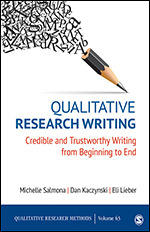Qualitative Research Writing
Credible and Trustworthy Writing from Beginning to End
- Michelle Salmona - Institute for Mixed Methods Research
- Dan Kaczynski - Central Michigan University
- Eli Lieber - University of California, Los Angeles, USA
Qualitative Research Methods
This book provides a detailed account of how to think about enacting the process of qualitative research for students. Beginning with the brainstorming process of writing and moving through the critical components of qual research, the book helps students new to these concepts feel more familiar with qualitative research.
This book provides your students with a roadmap for writing up qualitative research projects. It's a good length and level of detail for undergraduate or early-stage graduate students.
Chapters 7 and 8 are CRUCIAL for my students. I have to do a lot of explaining around writing up findings, discussion, and conclusion. I offer lots of examples, but these chapters put it all into easily digestible bites, with really good examples. I would definitely use these chapters – they are excellent.
This book is a primer on how academic research writers can effectively begin, think about, and accomplish qualitative research.
There are some helpful tips for students. For example, the tips to self-evaluate and acknowledge one's role in the research process and to start writing even if the ideas are not clear yet are things I cover with every cohort of students I teach and are useful to include in the text.
This book will really help our graduate students think about writing as a process and not as a product — something they really need to understand.
The accessibility of the language and how the text focuses on leading the student through the writing process to support them in making connections between their research questions, research purpose, and data makes this book distinct from others.
This is a great book with detailed steps of considerations and tasks needed to complete each step of the research process.
Challenging topics are addressed in a clear and easy-to-comprehend format. The tools and strategies shared are very useful and show the reader that there is no one right way of doing things in qualitative research. There are multiple options to choose from based on personal preferences and ways of doing things. The chapters provide a good framework to guide students and novice researchers through the process.
Whilst I meant to dip in and out of this book there are many chapters that I sat and read through due to their motivational and interesting viewpoints. This book is very relatable to problems that students find challenging such as how to write themes and introductions and conclusions to chapters. Many of the topics such as "joining the conversation" struck a cord with my own experiences too as a nurse and educator.


